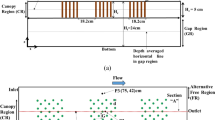Abstract
In formulating problems concerning physical models of hydrodynamic processes, it is generally impossible objectively to take into account quantitatively most factors because of their wide diversity and variability. Another significant impediment is the absence of a unified and universally accepted theory of mass transfer in micro- and ultrafiltration. Noteworthy is the particular complexity of transmembrane transfer with developed flow instabilities of varying intensity because any (even insignificant) change in the process parameters of micro- and ultrafiltration leads to different conditions of the formation (or destruction) of the surface layer, which inevitably influences boundary conditions. In this work, it was shown that a one-parameter diffusion model can be adapted to the membrane separation process by taking into account the permeability of one of the walls of a rectangular channel under consideration. The flow pattern was studied to determine the behavior of the solute concentration field on the membrane surface and to evaluate the efficiency of measures taken to reduce the concentration polarization in hydrodynamic methods by varying the velocity.















Similar content being viewed by others
REFERENCES
Akhmadiev, F.G., Farakhov, M.I., Bekbulatov, I.G., and Isyanov, Ch.Kh., Mathematical modeling of filtering process of two-phase suspensions in tubular filters under nonisothermal conditions, Theor. Found. Chem. Eng., 2016, vol. 50, no. 1, pp. 41–51. https://doi.org/10.1134/S0040579516010012
Gan, Q., Howell, J.A., Field, R.W., England, R., Bird, M.R., O’Shaughnessy, C.L., and McKechinie, M.T., Beer clarification by microfiltration — Product quality control and fractionation of particles and macromolecules, J. Membr. Sci., 2001, vol. 194, no. 2, pp. 185–196.https://doi.org/10.1016/S0376-7388(01)00515-4
Hunt, J.W., Brouchaert, C.J., Raal, J.D., Treffry-Goatley, K., and Buckley, C.A., The unsteady-state modelling of cross-flow microfiltration, Desalination, 1987, vol. 64, pp. 431–442. https://doi.org/10.1016/0011-9164(87)90115-9
Babenyshev, S.P., Chernov, P.S., and Mamai, D.S., Modeling of the membrane filtration of liquid systems, Nauchn. Zh. Kuban. Gos. Agrar. Univ., 2012, no. 76 (02), pp. 1–11.
Bazhenov, V.I. and Ustyuzhanin, A.V., Mathematical model for biological purification of wastewater taking into account hydrodynamic and non-steady-state conditions, Vestn. Irkutsk. Gos. Tekh. Univ., 2014, no. 11 (94), pp. 128–133.
Gorbunova, Yu.A. and Timkin, V.A., Hydrodynamics of microfiltration and ultrafiltration separation of milk and curd, Agrar. Vestn. Urala, 2016, no. 6 (148), p. 70.
Lobasenko, B.A. and Pavskii, V.A., Determination of the concentration of solutes in the boundary layer on the membrane surface, Izv. Vyssh. Uchebn. Zaved., Pishch. Tekhnol., 2001, nos. 2–3, p. 68.
Semenov, A.G., Evolution of the gel contamination of a membrane during tangential ultrafiltration of a solution of a high-molecular compound, Tekh. Tekhnol. Pishch. Proizvod., 2011, no. 1 (20), p. 1.
Bekker, V.F., Modelirovanie khimiko-tekhnologicheskikh ob"ektov upravleniya: uchebnoe posobie (Modeling of Chemical Engineering Processes: A Textbook), Moscow: RIOR-INFRA–M, 2014, 2nd ed.
Timashev, S.F., Fizikokhimiya membrannykh protsessov (The Physicochemistry of Membrane Processes), Moscow: Khimiya, 1998.
Bryk, M.T., Ul’trafil’tratsiya (Ultrafiltration), Kiev: Naukova Dumka, 1989.
Schmitz, P., Houi, D., and Wandelt, B., Hydrodynamic aspects of crossflow microfiltration: Analysis of particle deposition at the membrane surface, J. Membr. Sci., 1992, vol. 71, nos. 1–2, pp. 29–40. https://doi.org/10.1016/0376-7388(92)85003-2
Antipov, S.T., Kretov, I.T., Shakhov, S.V., and Klyuchnikov, A.I., Concentration polarization in beer clarification, Pivo Napitki, 2001, no. 3, p. 18.
Antipov, S.T., Shakhov, S.V., Ryazanov, A.N., Klyuchnikov, A.I., Blyakhman, D.A., and Vasil’chenko, A.N., RF Patent 2147459, Byull. Izobret., 2000, no. 11.
Laptev, A.G. and Lapteva, E.A., Determination of turbulent mixing coefficients in one- and two-phase media using the Taylor model, Fundam. Issled., 2015, no. 2, p. 2810.
Author information
Authors and Affiliations
Corresponding author
Additional information
Translated by V. Glyanchenko
Rights and permissions
About this article
Cite this article
Antipov, S.T., Klyuchnikov, A.I. Mathematical Modeling of Microfiltration in a Rectangular Channel. Theor Found Chem Eng 53, 83–96 (2019). https://doi.org/10.1134/S0040579518060027
Received:
Revised:
Accepted:
Published:
Issue Date:
DOI: https://doi.org/10.1134/S0040579518060027




